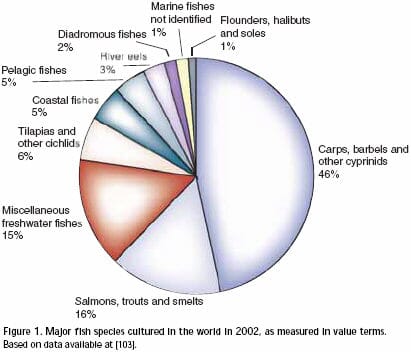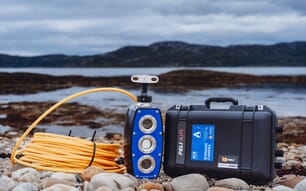In addition to salmon and trout, commercial vaccines are available for channel catfish, European seabass and seabream, Japanese amberjack and yellowtail, tilapia and Atlantic cod. In general, empirically developed vaccines based on inactivated bacterial pathogens have proven to be very efficacious in fish. Fewer commercially available viral vaccines and no parasite vaccines exist. Substantial efficacy data are available for new fish vaccines and advanced technology has been implemented.
However, before such vaccines can be successfully commercialized, several hurdles have to be overcome regarding the production of cheap but effective antigens and adjuvants, while bearing in mind environmental and associated regulatory concerns (e.g., those that limit the use of live vaccines). Pharmaceutical companies have performed a considerable amount of research on fish vaccines, however, limited information is available in scientific publications.
In addition, salmonids dominate both the literature and commercial focus, despite their relatively small contribution to the total volume of farmed fish in the world. This review provides an overview of the fish vaccines that are currently commercially available and some viewpoints on how the field is likely to evolve in the near future.
Aquacuiture: agriculture of the oceans
Aquacuiture is growing more rapidly than all other food animal producing sectors; its contri button to global supplies of fish, crustaceans and molluscs increased from 3.9% of total pro duction by weight in 1970 to 29% in 2001 [101]. As the capture fishing industry has declined and wild stocks diminished, the aquaculture industry has become an important source of seafood. China is the largest fish pro ducer, with 70% of the total volume and 53% of total value in 2002 1102,1031. Today, carps, barbels and other members of the cyprinid family dominate fish aquacuiture (FIGURE l).
These fish species have a relatively low value compared with other types of farmed fish and are typically raised in simple pond systems where they are a food source for families in developing countries. The tendencies are, however, that all fish farming will become more industrialized with the increasing investment from multinational companies. Today, high value species, such as salmon and trout, account for 7% of total volume and 16% of total value of cultivated fish worldwide.
Atlantic salmon is one of the most intensively farmed fish in the world, with Norway, Chile, the UK and Canada being the major produc ers. Farming of high value marine species such as European seabass and seabream, halibut, flounder, cod, tuna, eel and amberjack/yellow tail will probably increase as appropriate inten sive aquacuiture systems are developed.
Although crustaceans (e.g., shrimp), molluscs (e.g., clams and oysters) and aquatic plants are important in global aquacuiture, they do not possess an adapted or specific immune system. Therefore, vaccines (at least by their traditional definition) are not appropriate for invertebrates and plants, and prophylactics in the farming of these aquatic organisms will not be reviewed in this article.
Vaccines & disease control
In all forms of intensive culture, where single or multiple species are reared at high densities, infectious disease agents are easily transmitted between individuals. Fish such as carp, often farmed in muddv ponds. appear to be more robust than, for instance, Atlantic salmon that arc adapted to spend their early life in clean, running fresh water. Independent of high or low technology farming, food environmental conditions are important to maintain a healthy fish population.
For species reared in nets in an open aquatic environment, exposure to pathogens is impossible to avoid. Due to the effectiveness of pathogen transportation in water and the high density of animals used in commercial large-scale farming, pathogens quickly spread within a population of cultured fish. During the 1980s, salmon farming in Norway experienced huge losses due to bacterial diseases (mostly Vibrio spp.) and a total crash in the industry was only prevented by the use of vast amounts of antibiotics (FIGURE 2).
Fish immersion vaccines based on formalin-inactivated broth cultures had proven to be effective against vibriosis in the USA in the 1970s and similar vaccines were quickly developed against the salmonid Vibrio diseases. The good efficacy of these vaccines immediately resulted in a decline in the use of antibiotics. However, a new bacterial disease, furunculosis [Aeromonas salmonicida] appeared and, as immersion vaccines proved ineffective against this pathogen, injectable vaccines containing adjuvants were developed in the early 1990s.
Following a few years of testing with different vaccine adjuvants and a range of different antigen combinations, it soon became evident that all antigens in one oil-adjuvanted vaccine was the product of choice. Tne excellent efficacy of these vaccines soon resulted in their extensive use and an immediate and permanent reduction in the use of antibiotics, concurrent with a three fold increase in fish production (FIGURE 2). With the exception of the introduction of a recombinant virus vaccine in 1995, vaccination strategies in the salmon farming industry have been more or less unchanged over the last 10 years.
Proper fish management with good hvgiene and limited stress are key factors in the prophylaxis of infectious diseases and are also a necessity for the optimal effect of vaccines. Today, vaccination is an integratal part of most salmon farms and the use of antibiotics is very limited, at least in Northern Europe and North America. The development of fish vaccines is, as with the development of human and veterinary vaccines, an ongoing interaction between academia, the pharmaceutical industry and regulatory authorities.
Until the earlv 1990s, most fish vaccines were developed and commercialized bv small local companies. During the 1990s and to date, Five multinational animal health compa nies have acquired, or formed, joint venture companies with the smaller companies specializing in the field of aquaculture vaccines. The major producers of fish vaccines are now: Intervet International (The Netherlands). Novartis Animal Health (Switzerland), Schering Plough Animal Health (USA), Pharmaq (Norway: was part of Alpharma Animal Health until 2004) and Bayer Animal Health (Bayotek)/Microtek. Inc. (Germany/Can ada). The major commercial markets for these companies are currently the salmon and trout industries in Northern Europe, Chile, Canada and the USA where the value of a healthy population justifies the price paid per vaccine dose.
Vaccines used in Japan are mostly developed and distributed by Japanese companies. Commercial vaccines are also available for the catfish industry in the USA and, on a smaller scale, for European seabream, seabass and tilapia. Some limited use, locally developed vaccines are also available in countries such as China, Russia, Spain and Germany.
Administration methods & factors affecting efficacy
Oral vaccination with antigen included in the feed would be the ideal method of vaccine delivery to fish and much effort has been put into the development of such vaccines. However, poor and inconsistent responses have been reported by conventional oral vaccines due to antigen destruction in the gut. Different approaches to protect the antigen from degradation, such as entrapping in liposomes or alginate beads, neutralization of gastric secretions or application of biofilm vaccines, have demonstrated some promising results.

Further Information
To continue reading the full article, including tables, click here (PDF)
September 2006


